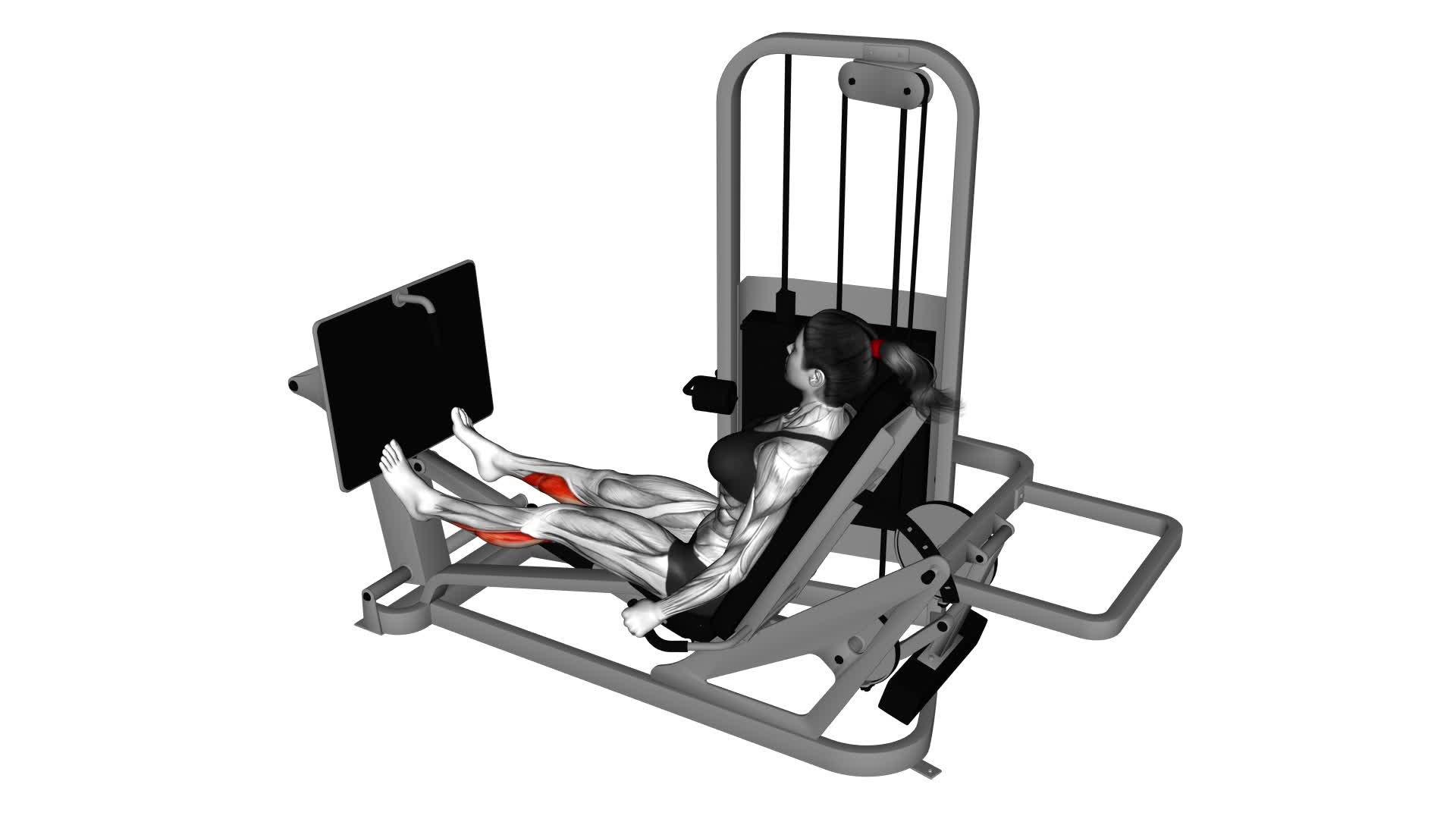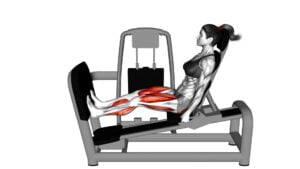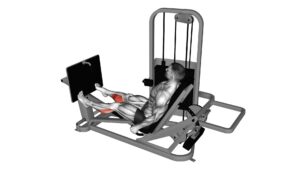Lever Seated Calf Press (female) – Video Exercise Guide & Tips

Get ready to strengthen and tone your calf muscles with the lever seated calf press. In this video exercise guide, you'll learn proper equipment setup, correct seated positioning, and tips for maximizing calf muscle engagement.
Watch This Exercise Video
With safety precautions and modifications, you'll feel confident and motivated to take your calf workout to the next level.
Watch the video and get started on your journey to stronger, more defined calves.
Key Takeaways
- Proper equipment setup and seated positioning are important for performing the lever seated calf press correctly.
- Maintaining a strong and controlled movement throughout the exercise is essential for maximizing calf muscle engagement.
- Safety precautions and modifications, such as starting with an appropriate weight and adjusting seat position for proper alignment, should be followed to avoid discomfort or injury.
- Post-workout soreness can be reduced by incorporating proper warm-up and cool-down routines, gradually increasing exercise intensity, and using recovery techniques like foam rolling and stretching.
Proper Equipment Setup
To properly set up the equipment for the Lever Seated Calf Press exercise, gather an adjustable calf press machine and position yourself in a seated position. This exercise is great for targeting and strengthening the calf muscles.
Begin by adjusting the machine's seat height so that your knees are at a 90-degree angle when seated. Place your feet on the footrest, ensuring that the balls of your feet are positioned securely on the platform. Adjust the weight stack according to your fitness level and desired intensity.
Once you're seated and properly positioned, grip the handles firmly with your hands for stability. Maintain a straight back and engage your core muscles throughout the exercise.
From this starting position, push the platform down by extending your ankles and raising your heels towards the ceiling. Ensure that your knees stay stationary and your heels don't lift off the platform.
Pause for a moment at the bottom of the movement, then slowly return to the starting position. Repeat for the desired number of repetitions.
Remember to listen to your body and adjust the weight accordingly to prevent injury.
Correct Seated Positioning
Position yourself in a seated position that allows for proper alignment and stability for the Lever Seated Calf Press exercise. Sit on the edge of a sturdy bench or seat with your feet flat on the platform of the calf press machine. Make sure your knees align with the pivot point of the machine. Adjust the seat height so that your knees are bent at a 90-degree angle when your feet are on the platform.
Maintain an upright posture throughout the exercise. Keep your back straight and engage your core muscles to stabilize your body. Place your hands on the handles provided for support.
Proper seated positioning is crucial for maximizing the benefits of the seated calf press exercise. It helps target the calf muscles effectively while minimizing the risk of injury. By maintaining the correct seated position, you can isolate the calf muscles and prevent compensation from other muscle groups.
To add variety to your calf training routine, there are several seated calf press variations you can try. You can perform the exercise using different foot positions, such as toes pointed inwards or outwards, to target different areas of the calf muscles. Additionally, you can adjust the weight and repetitions to customize the intensity of the exercise.
Remember to always consult with a fitness professional before attempting any new exercises, especially if you have any pre-existing conditions or injuries.
Performing the Lever Seated Calf Press
Situate yourself in the proper seated position to perform the Lever Seated Calf Press exercise, ensuring that your feet are securely planted on the platform and your knees align with the machine's pivot point. Proper equipment setup and seated positioning are crucial for maximizing the effectiveness of this exercise.
To begin, adjust the seat height so that your knees are at a 90-degree angle when your feet are fully extended on the platform. This will help maintain proper form throughout the exercise. Make sure the seat is also positioned in a way that allows your feet to comfortably rest on the platform without any strain on your ankles.
Once you're properly seated, position your feet hip-width apart, with your toes pointing forward. This will engage your calf muscles effectively during the exercise. Keep your upper body upright and maintain a neutral spine throughout the movement.
To perform the Lever Seated Calf Press, push through the balls of your feet and raise your heels as high as possible, contracting your calf muscles. Hold the peak contraction for a moment, then slowly lower your heels back down to the starting position.
Remember to breathe throughout the exercise and focus on maintaining control and proper form. Adjust the weight as needed to challenge your calf muscles without sacrificing your technique.
Tips for Maximizing Calf Muscle Engagement
To effectively engage your calf muscles during the Lever Seated Calf Press, focus on maintaining a strong and controlled movement throughout the exercise. This will help you maximize the activation of your calf muscles and achieve better results.
When performing calf muscle exercises like the Lever Seated Calf Press, it's important to pay attention to your form and technique. Start by adjusting the seat and foot platform to a comfortable position. Place the balls of your feet on the platform, with your heels hanging off. Keep your back straight and core engaged throughout the exercise.
As you press the weight up using your calves, avoid using momentum or jerking movements. Instead, focus on a slow and controlled movement, squeezing your calf muscles at the top of the movement. This will ensure that your calf muscles are fully engaged and stimulated.
To further maximize calf muscle engagement, consider incorporating calf muscle strengthening techniques such as performing the exercise with one leg at a time or using resistance bands for added resistance. Remember to start with lighter weights and gradually increase the load as your calf muscles get stronger.
Safety Precautions and Modifications
Make sure to prioritize safety and make necessary modifications when performing the Lever Seated Calf Press exercise. Safety should always be your top concern to prevent injuries and ensure a successful workout.
Here are some important safety precautions and modifications to keep in mind:
- Start with an appropriate weight: Begin with a weight that allows you to maintain proper form and control throughout the exercise. Gradually increase the weight as you become stronger and more comfortable with the movement.
- Maintain proper form: Keep your back straight and shoulders relaxed throughout the exercise. Avoid leaning forward or arching your back, as this can strain your lower back and increase the risk of injury.
- Adjust the seat position: Ensure that the seat is adjusted to your height and provides proper alignment for your body. This will help you maintain stability and minimize the risk of injury.
- Listen to your body: Pay attention to any discomfort or pain during the exercise. If you experience any unusual sensations, stop immediately and consult a fitness professional or healthcare provider.
- Warm up and cool down: Always warm up your calf muscles before starting the Lever Seated Calf Press exercise. Stretching and performing light cardio exercises can help prepare your muscles for the workout. Similarly, include a cool down routine to help your muscles recover and prevent post-workout soreness.
Frequently Asked Questions
How Many Sets and Repetitions Should I Do for the Lever Seated Calf Press?
For the lever seated calf press, it's important to find the right balance between weight and resistance. Start with a weight that challenges your calf muscles, but allows you to complete the desired number of sets and repetitions with proper form.
Aim for 3-4 sets of 10-15 repetitions, resting for 1-2 minutes between sets.
Can I Use Dumbbells Instead of the Lever Machine for This Exercise?
Yes, you can use dumbbells as an alternative for the lever machine in this exercise.
Dumbbells can be an effective tool for calf exercises.
To perform a seated calf press with dumbbells, sit on a bench with your feet flat on the ground and hold a dumbbell on each knee.
Push through your toes to raise your heels off the ground, then slowly lower them back down.
Repeat for the desired number of repetitions.
Should I Perform the Lever Seated Calf Press Before or After Other Leg Exercises?
Before or after other leg exercises, it's up to you.
However, it's generally recommended to perform pre-workout stretching, including calf stretches, to warm up the muscle.
The lever seated calf press can help strengthen and tone your calf muscles.
It targets the gastrocnemius and soleus muscles, which play a crucial role in lower body movements.
Incorporating this exercise into your leg routine can provide additional benefits and enhance overall leg strength and stability.
Can I Do This Exercise if I Have a Previous Calf Injury?
Yes, you can still do this exercise if you have a previous calf injury.
However, it's important to consult with a healthcare professional or a physical therapist beforehand.
They can provide you with specific rehabilitation exercises for your calf injury and guide you on how to perform the lever seated calf press without straining your injury.
If necessary, they may also suggest alternative exercises that can help strengthen your calves without putting too much stress on your previous injury.
How Long Should I Rest Between Sets When Doing the Lever Seated Calf Press?
When it comes to the lever seated calf press, it's important to know how long to rest between sets. Rest periods between sets for this exercise can vary depending on your fitness level and goals.
Generally, it's recommended to rest for about 30 seconds to 1 minute between sets. This will allow your muscles to recover and replenish their energy stores, maximizing the benefits of the lever seated calf press.
Conclusion
In conclusion, the lever seated calf press is an effective exercise for targeting and strengthening the calf muscles. By following proper equipment setup, correct seated positioning, and engaging the calf muscles throughout the movement, individuals can maximize their calf muscle engagement and achieve desired results.
It's important to prioritize safety and make any necessary modifications to ensure a safe and effective workout. Incorporating the lever seated calf press into a well-rounded fitness routine can contribute to overall lower body strength and stability.

Author
Years ago, the spark of my life’s passion ignited in my mind the moment I stepped into the local gym for the first time. The inaugural bead of perspiration, the initial endeavor, the very first surge of endorphins, and a sense of pride that washed over me post-workout marked the beginning of my deep-seated interest in strength sports, fitness, and sports nutrition. This very curiosity blossomed rapidly into a profound fascination, propelling me to earn a Master’s degree in Physical Education from the Academy of Physical Education in Krakow, followed by a Sports Manager diploma from the Jagiellonian University. My journey of growth led me to gain more specialized qualifications, such as being a certified personal trainer with a focus on sports dietetics, a lifeguard, and an instructor for wellness and corrective gymnastics. Theoretical knowledge paired seamlessly with practical experience, reinforcing my belief that the transformation of individuals under my guidance was also a reflection of my personal growth. This belief holds true even today. Each day, I strive to push the boundaries and explore new realms. These realms gently elevate me to greater heights. The unique combination of passion for my field and the continuous quest for growth fuels my drive to break new ground.



